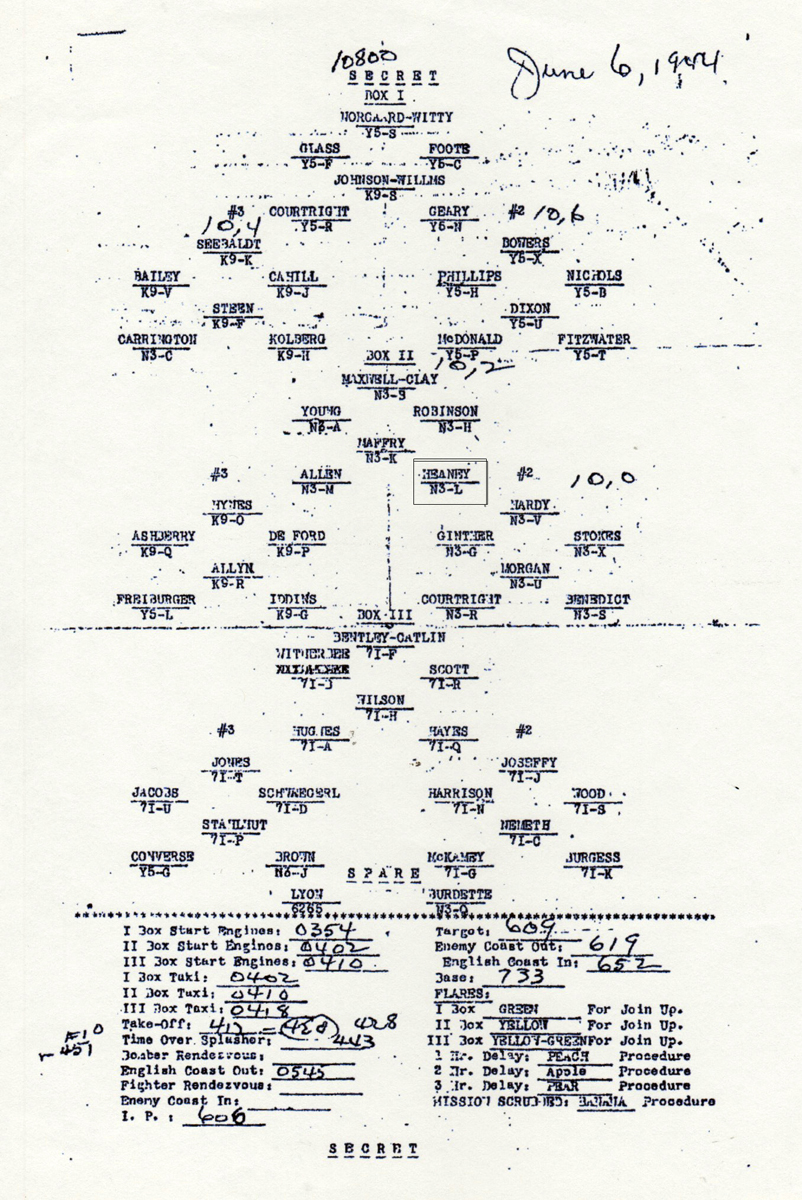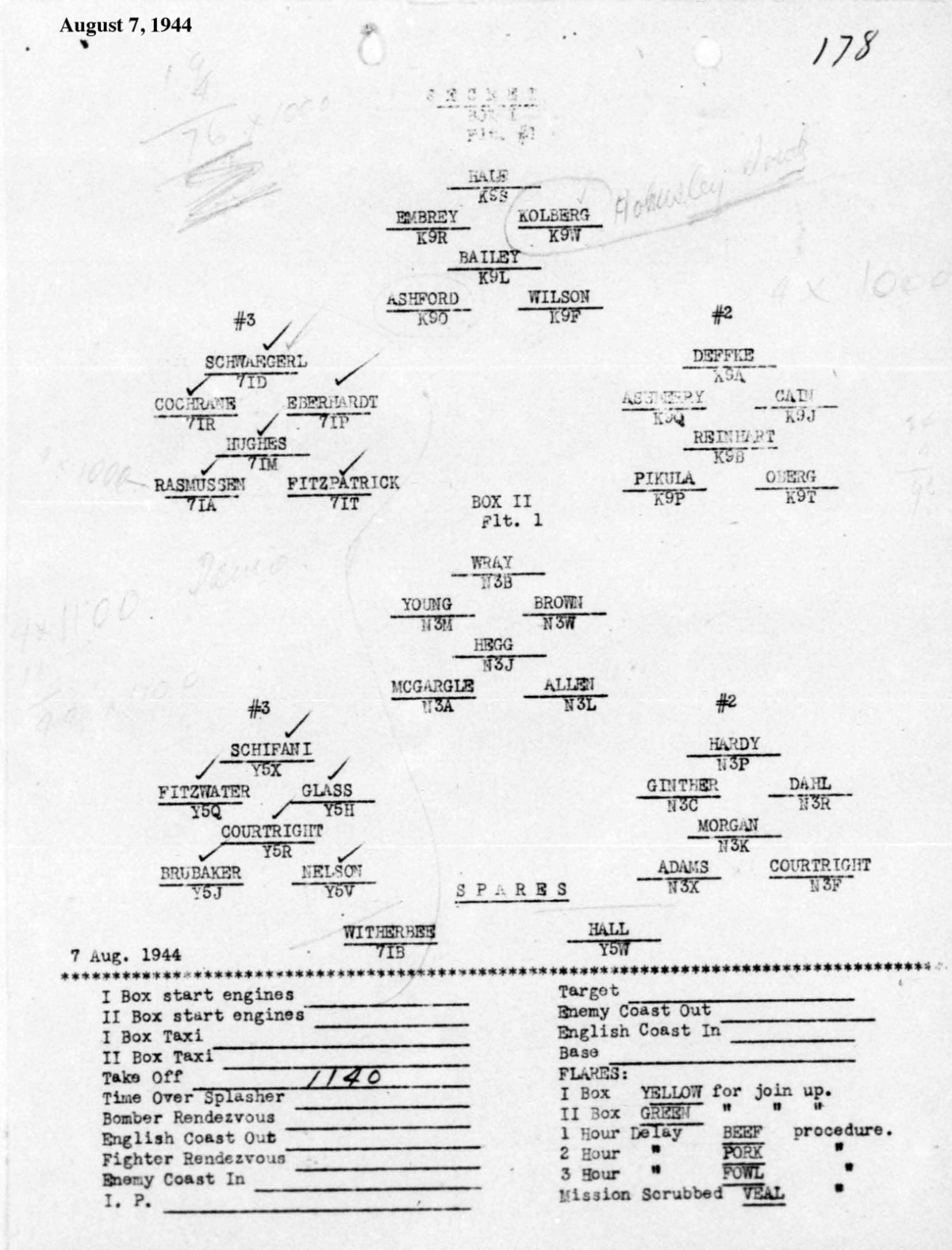2nd Lt. Charles Middleton
 “I was born on November 4, 1923. On D-Day I was a member of the 496th Bomb Squadron, 344th Bomb Group, 99th Wing, IX Bomber Command, 9th Air Force, US Army Air Corps from 1943-44.
“I was born on November 4, 1923. On D-Day I was a member of the 496th Bomb Squadron, 344th Bomb Group, 99th Wing, IX Bomber Command, 9th Air Force, US Army Air Corps from 1943-44.
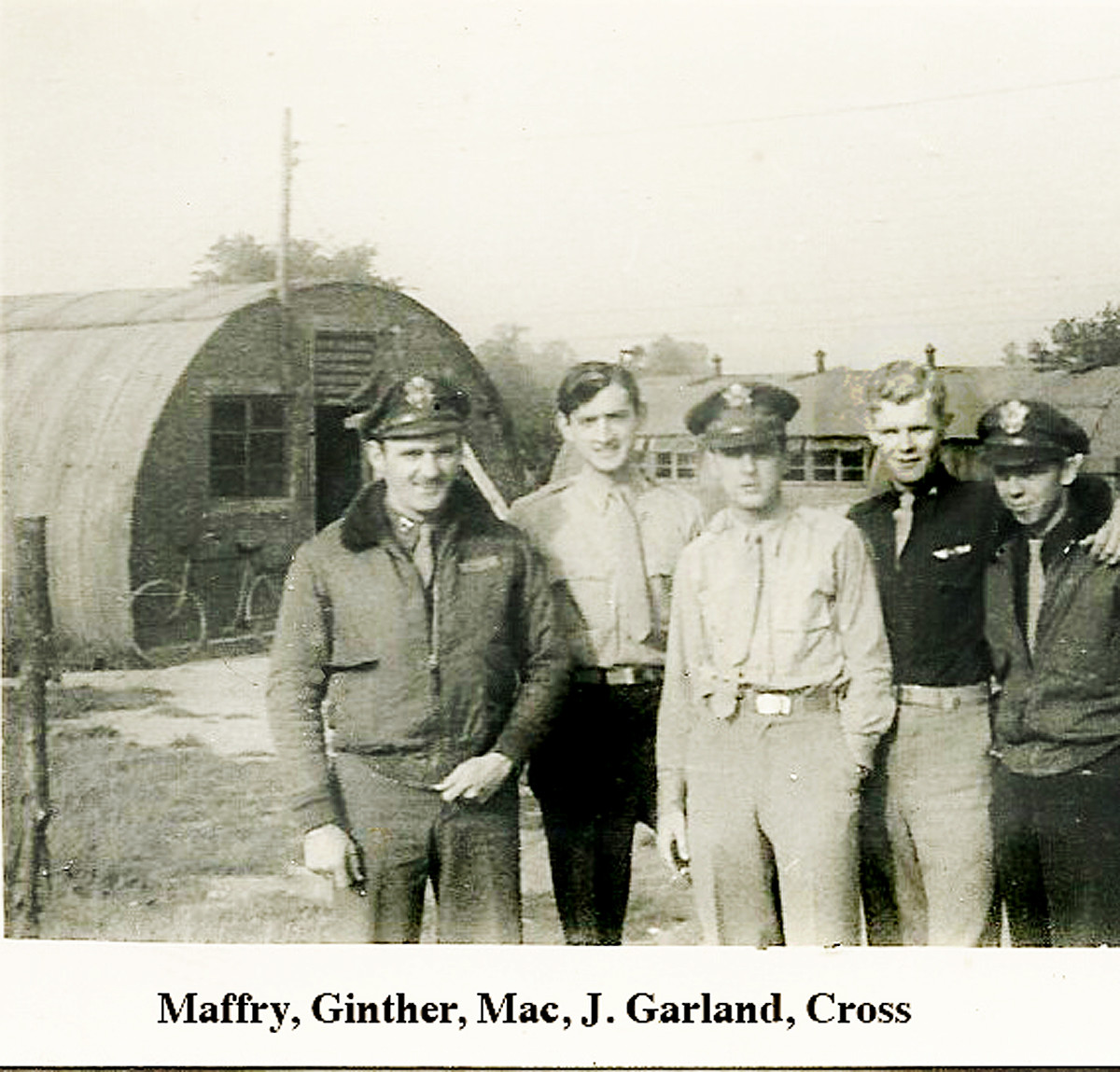 I entered service at Baer Field., Ft. Wayne, IN as a private after passing the Aviation Cadet examination on 31 March 1942. I was given an indefinite furlough until I reported. to the San Antonio Aviation Cadet Center, 27 August 1942 and on D-Day I was a 2nd Lieutenant. I retired from the USAF on 1 December 1968 with the rank of Major.
I entered service at Baer Field., Ft. Wayne, IN as a private after passing the Aviation Cadet examination on 31 March 1942. I was given an indefinite furlough until I reported. to the San Antonio Aviation Cadet Center, 27 August 1942 and on D-Day I was a 2nd Lieutenant. I retired from the USAF on 1 December 1968 with the rank of Major.
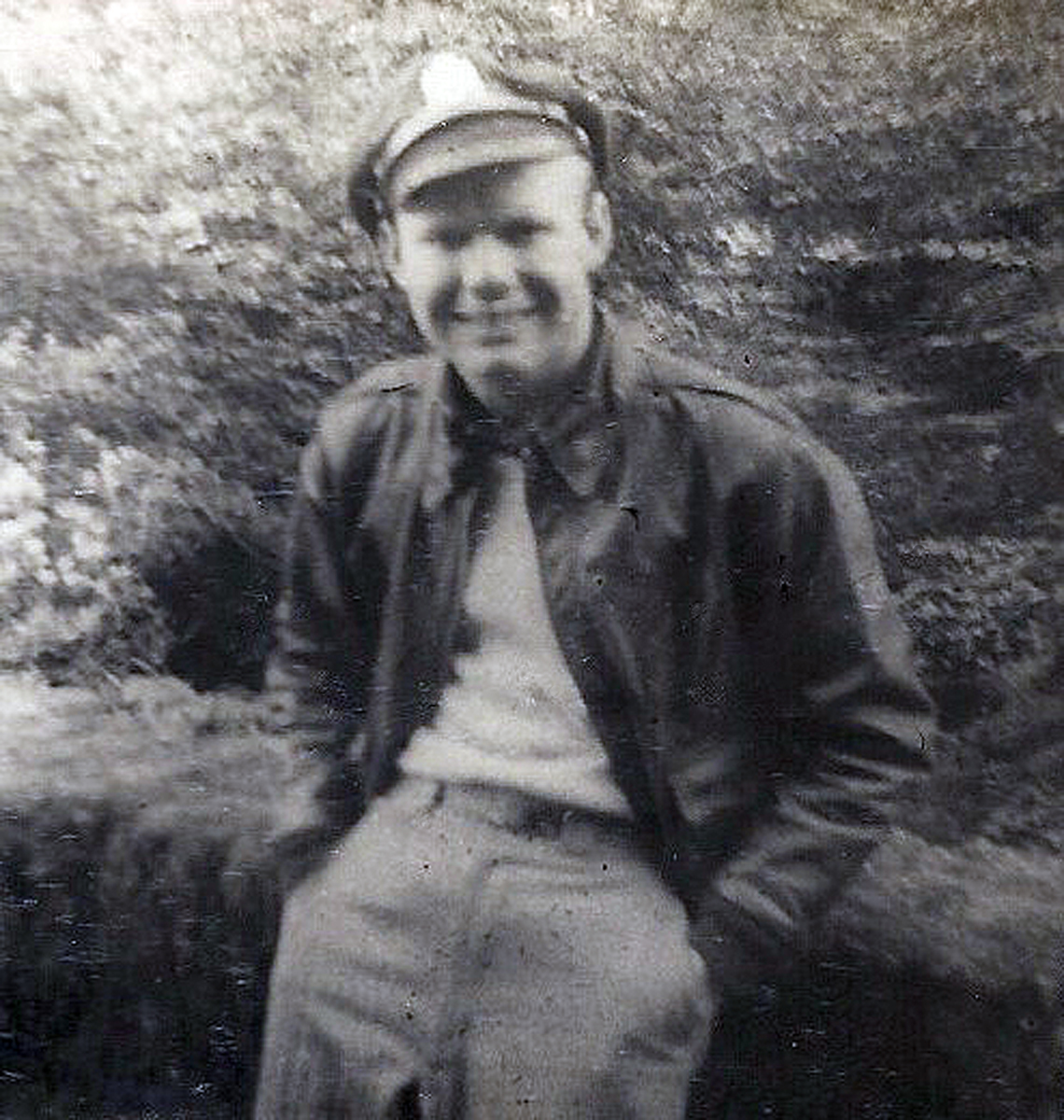 My training commenced at the San Antonio Aviation Cadet Center in pilot preflight, class 43-D, Upon completion of that I was sent to primary flight school in Stanford, Texas. I washed out of pilot training with19 hours and 18 minutes of flight training. I was told I was eligible for either navigation or bombardier training. I chose the latter because the course was shorter.
My training commenced at the San Antonio Aviation Cadet Center in pilot preflight, class 43-D, Upon completion of that I was sent to primary flight school in Stanford, Texas. I washed out of pilot training with19 hours and 18 minutes of flight training. I was told I was eligible for either navigation or bombardier training. I chose the latter because the course was shorter.
I took bombardier pre-flight training at Ellington Field, Houston, Texas, class of 43-8, and upon. completion went to bombardier flight training at Concho Field, San Angelo, Texas, This was completed on 3 June 1943. I received the aeronautical rating of Aircraft Observer, Bombardier and was commissioned a 2nd Lt. Further trained in dead reckoning navigation was completed at Carlsbad Army Air Field, Carlsbad, NM in mid-July 1943.
I reported to combat crew training in the B-26 Marauder at Barksdale AAF, Shreveport, LA, arriving there about 28 July 1943. I was assigned to the 475th Bomb Squadron, II1 Bomber Command, 3rd Air Force. This organization was strictly for combat crew training. I had my first flight in a B-26 on 10 August 1943. By the time I completed the first phase of this training I had accumulated approximately 71 hours of flight time in the B-26. In addition to further training on the Norden bombsight we were also introduced to the D-8 bombsight, designed for low-level bombing. Gunnery, formation flying., night bombing and general introduction to the Marauder helped prepare the crews for combat duties.
I was transferred to the 477th Bomb Squadron, same command, and assigned to a crew about mid-December 1943. Pilot, Ogden D. Ginther; Co-Pilot, John J. McCauley; Flight Engineer, jack Nabors; Radio Operator, Norris C. Hyre; Gunner, Charles Christopher. We completed our training as a crew and were transferred to Hunter AAF, Savannah, GA in early 1944. The bombardiers and gunners remained at Hunter while the rest of the crew flew a Marauder to the U.K. Sgt. Christopher and I went to New York and sailed for England on the Aquatania, landing at Greenock, Scotland in late March, 1944. While at Barksdale with the 477th 1 received another 98 hours in the B-26 making a total of approximately 170 hours of combat crew flight training.
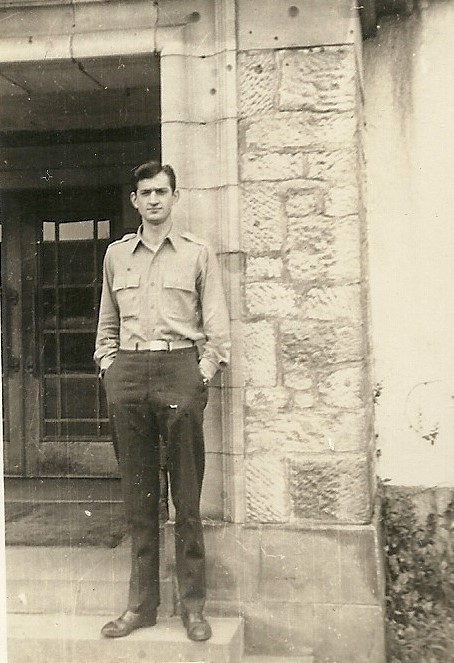 After landing at Greenock we were sent to an air base, Toombe Bridge, near Belfast, Ireland for further ground school, Here we were rejoined by the other members of the crew.
After landing at Greenock we were sent to an air base, Toombe Bridge, near Belfast, Ireland for further ground school, Here we were rejoined by the other members of the crew.
While in Ireland, orders were received to join the 496th Bomb Squadron, 344th Bomb Group, 99th Wing, IX Bomber Command, 9th Air Force at Stansted RAF Station 169, near Bishops Stortford, Hertfordshire, England.
Our crew arrived at Stansted on April 22, 1944. I flew two practice missions, one on April 24th and one on the morning of the 25th. My first combat sortie was flown in the afternoon of the 25th. By the end of April I had a total of 4 combat sorties.
During the month of May we continued to fly more combat sorties against a variety of targets, mostly bridges and RR marshalling yards. By the end of May I racked up 22 more sorties.
During the first 5 days of June our crew flew 3 combat sorties and 1 training mission, an early dawn take-off and form up. The 3 combat sorties were: June 2nd, gun position at Quend, Normandy; June 4th, RR bridge at Courselles-sur-Seine and on June 5th at a headquarters shelter at Wissant also in Normandy.
During late May and early June we were all aware that something big was coming off, many of us thought of invasion. Black and white recognition stripes had been painted on our B-26s. About the 2nd of June newsmen began moving onto our base, in fact we had a reporter from The Baltimore Sun quartered in our hut but he did not fly with our crew. Actually except for the stripes and the reporters, operations seemed. to be normal. At 0100 hours on the 6th of June 1 was sleeping soundly only to be aroused by the G.Q. about 0130 hours for the morning briefing. I haven’t the slightest idea of what I had for breakfast. As for clothing, I wore what I usually wore to fly a combat sortie a uniform shirt and trousers over my Balbriggan pajamas and a flight suit over the uniform plus an A-2 jacket. I wore my billed, ’50 mission crush’ hat because a flak helmet fitted over it. I had on my brown riding hoots, they wouldn’t come off if we had to bail out and my fleece-lined flying boots fitted better than with the GI boot. In-flight clothing of a sort was added, a Mae West flotation jacket, a parachute harness; 1 kept my chest pack on the radio operator’s table. Over all this went a flak jacket, usually donned when nearing the French Coast.
The mission briefing took place at 0230 hours. One of the main points I vividly recall was the number of German aircraft that could be brought againstus, but, not to worry, there would be 7000 Allied airplanes in the air. The weather was ghastly, low clouds, drizzle and fog. As I recall we took off about 0400 hours. The attempt to join up in proper formation was a mess. We missed the main formation and chased the group halfway across tlic Channel and as the sky brightened we caught up with them and 344th Bomb Group took a position that looked empty. I thought then and still do that I Was in the 13th Marauder to cross the Utah beach head, regardless of mission logs, group histories and that sort of thing. The 344th Silver Streaks had been selected to lead all the other B-26 groups so we were the first.
Click formation diagram to enlarge
Crossing the Channel it looked to me as if you could walk ship to ship without getting your feet wet. As we neared the coast we could see naval gunfire and some return fire. I remember a battleship of tile Texas class with the basket upperworks firing the big guns. We were scheduled to be over the beach before the troops came ashore, about 0630 hours.
Click on Loading List below to see the crew list and position on D-Day (1)
Click to enlarge
 Because of the low cloud deck our bombing altitude was low, about 3500 feet. We flew parallel to the shore line and dropped our 250 pound bombs directly on the beach and in the sand. I thought to myself that we are digging foxholes and exploding mines, although official reports say differently. Gunners in airplanes ahead of us were firing at the ground although I could not see anything to shoot at; I tried to find something, but couldn’t. Empty brass and machine gun links were falling around us from those airplanes and I was afraid we might get damaged. I would not let my gunners fire and that made them a little unhappy with me.
Because of the low cloud deck our bombing altitude was low, about 3500 feet. We flew parallel to the shore line and dropped our 250 pound bombs directly on the beach and in the sand. I thought to myself that we are digging foxholes and exploding mines, although official reports say differently. Gunners in airplanes ahead of us were firing at the ground although I could not see anything to shoot at; I tried to find something, but couldn’t. Empty brass and machine gun links were falling around us from those airplanes and I was afraid we might get damaged. I would not let my gunners fire and that made them a little unhappy with me.
After our drop we made a sharp right turn and flew south and then west over the base of the Cherbourg Peninsula. On the ground there were various colored parachutes everywhere. Glider, or parts of gliders were scattered all over You could see where they had gone through hedge rows, leaving wings behind, some had burnt and some were still intact although not many. Not far from the battle zone a farmer was plowing his field. He had a white horse and was seemingly unconcerned about all that was happening around him. Would you call that ‘savoir faire?’
Because we were among the first to bomb we did not receive the enemy opposition reported by following aircraft. I saw one bright red ME 109. It flew at our altitude but stayed well away from the formation. As far as we were concerned it was a `milk run.’ The return to Stansted, 3:50 hours later, was uneventful. Thus ended my 30th combat sorties.
What were my thoughts? Was I frightened? My thoughts were mostly about the poor bastards on the ground and I was glad to be in the air. Did I think about the momentous happenings? I doubt it. Frightened? Not particularly, after all I was a 20 year old 2nd Lt. on combat status flying in the best air- plane and with the best crew so what could happen?
Our crew on that clay was the same one that had been formed at Barksdale 6 months before and we had flown most of our missions together. I finished my tour on 11 September 1944 with 67 com-bat sorties and 230 hours of combat time. Nearly 50 years later I look back on my brief period with the ‘Silver Streaks’ as amongst the most exciting days. I can say with pride, “I was there. I was there with the best Marauder outfit in England and i was there for the greatest invasion in history!” Even though I was recalled for the Korean War and flew another 21 sorties in B-29s, nothing can compare to the days with the 344th!”
————————————————-
On August 7th, 1944 the 344th BG including Ginther, McAuley, Middleton, and crew were assigned to bomb tanker ships in Brest Harbor.
Note Ginther and crew near the bottom right of the formation diagram.
Click to enlarge.
.
.Note Loading List for the Aug. 7, 1944 mission.
Stubborn in resistance bordering on fanaticism at the city of Brest to deny the harbor facilities to our forces made that sector a major campaign. In the harbor were two tankers anchored inside the breakwater and in toward the city. These vessels were loaded with cement and could be moved into the small channel created by the breakwater and sunk there by the enemy and effectively block the entrance to our water traffic when their capitulation eventually would take place. The American command, anticipating the Germans might so reason the same is they, decided to sink these tankers by air action at the point of anchor inside the harbor and render them harmless to such a plan.
Fitting in with this program the 344th dispatched 36 airplanes to bomb the ships on 7 August. Visibility that day was very favorable and the boats could be easily spotted though they appeared as mere specs in the water from 12,000 feet, the altitude of attack. Flak defenses of the enemy opened up prior to the bomb run and the planes flew down a gauntlet of steel thrown up at them.
The converging flights never wavered from their purpose, and the bombardiers sighted and dropped their bombs as briefed. The results were several near misses on both vessels and two or more direct hits as the bombs walked across the aft end of one of the tankers to give the group a rating of good to excellent for that mission. Damage to the group tallied 26 category A and two of our personnel slightly wounded.
——————————————–
2nd Lt. Charles Middleton wrote many anecdotes included in Stovall’s Book, Tales of the Marauders. The include serious and humorous incidents and provide a good cross-section of his WWII experience.
OUR ONE CRASH LANDING
By Charles Middleton, 344th Bomb Group, 496th Squadron
We had one crash landing. The right gear wouldn’t lock down and upon touch down it started to fold. Ginther held it off as long as he could and the right wing tip slowly sank until it touched the runway. The prop cut through the side of the airplane at just about the radio operator’s position, Norris Byre, our radioman received a small cut, no Purple Heart, and got some blood on his parka sleeve. I kept that parka for years, but it has now disappeared. We all rode away from the crash site in an ambulance, but other than Byre, no one was injured.
GERMAN FIGHTER AIRCRAFT VERSUS SPITFIRES
By Charles Middleton, 344th Bomb Group, 496th Squadron
On my 67 combat sorties I saw a total of 7 German aircraft. Four were twin engine bombers, Heinkel 111K ‘s, or maybe just mock-ups to attract an unwary fighter or bomber into a trap. I’ll never know. The 5th was a red ME-109 on D-Day, he presented no problem, stayed some distance away. On one mission a Focke-Wulf 180 streaked straight up through the B-26 formation, that was number six.
The 7th was a little more exciting. We were returning on one engine after a mission and we were somewhere over the southern end of the Cherbourg peninsula. Fair weather cumulus clouds dotted the sky. All of a sudden here comes an ME-109, he came from the right, slightly high and started a curve ahead of us. It looked to be preparatory to a firing pass. I quickly removed the bombsight head and literally threw it back to the co-pilot, John MacAuley. It was easy to do, I had just turned it off and the gyro was still turning. The inertia made it easy. I unsnapped the cable holding my flex gun and was trying to find the fighter in the sight.
Our top turret gunner, Jack Nabors, was also alert. We never got a chance to fire. When the German was coming out of his turn, two Spitfires came out of the clouds to our right and above. The German pilot lost all interest in us and beat a hasty retreat with both Spits after him.
BEST LANDING I’VE EVER SEEN
By Charles Middleton, 344th Bomb Group, 496th Squadron
I think the best landing I’ve ever seen was made by a B-26 from another group using Stansted as an emergency field. All tires had been flattened by flak and hung down from the landing gear. The pilot elected to land on the grass next to one of the runways.
A group of us were watching, I have regretted not having my camera all these years since. He touched down with the waist windows and the bomb bay doors open. I don’t think they rolled a hundred feet before the airplane stopped, and long before it stopped, almost at touch down, the crew was tumbling out of the bomb bays and the waist windows. Other than flat tires and bent wheel rims there was no apparent damage to the airplane.
A MISSION TO BREST, FRANCE
By Charles Middleton, Bombardier 344th Bomb Group, 496th Squadron
On a mission to Brest bombing tankers in the harbor, the group was flying through a box barrage. Suddenly one of the airplanes nosed upward, did a 180 degree turn and headed home. Smoke was pouring out of the exhausts, Ginther was on the inter-plane radio and called to the pilot of the other aircraft, John Haney, a good friend. “Where are you going?” “Home!” was the reply. A chunk of flak had come from above, hit the throttle column, pushed the throttles forward and broken them off. Haney flew the airplane back to Stanstcd and landed using prop pitch and mixture control.
That was my 54th combat sortie, August 7th, 1944.
A FLARE GUN AND FIRE ON BOARD
By Charles Middleton, 344th Bomb Group, 496th Squadron
We were in the landing pattern at Stansted, Jack Nabors was standing between the pilot and co-pilot watching the throttles. I was dozing with my head on my arms at the radio operator’s table.
The airplane hit some prop wash from an airplane ahead of us. It jarred Nabors and his shoulder hit the flare gun. The flare gun fell out of its bracket, hit the floor and went off. The flare landed on the table where I was napping, the explosion woke me up and all I saw at first was a bright light.
Nabors used the fire extinguisher to put out the flare and resulting flames and I opened the upper escape hatch to clear the smoke.
Ginther declared an emergency, fire on board, was cleared for immediate landing and I’ll be darned if another aircraft didn’t cut us out of the pattern! We had to go around again. We were told after landing that we looked like a steam locomotive, smoke was pouring out of the escape hatch like smoke from a stack. The only damage was a broken hydraulic line.
I’M HIT, BUT I’M AFRAID TO LOOK
By Charles Middleton, 344th Bomb Group, 496th Squadron
I do not recall the specific missions on which the following events occurred, so I will tell them as I remember them.
We had but one Purple Heart on our crew. Jack Nabors, the flight engineer got it. He flew top turret gunner and one trip he called over the interphone, “I’m hit!”
“Where?” I asked.
“In the foot!”
“How bad!”
“I don’t know! I’m afraid to take my shoe off!” Very plaintive.
He finally took his boot off and discovered a blood blister on his heel about the size of a quarter. A small piece of shell had gone through his fleece lined flying boot, entered his shoe at the seam between heel and sole and lodged there. His sock wasn’t torn, but he had to go to the Flight Surgeon to have the blister drained and it earned him a Purple Heart.
HANGING ONTO A ROPE OVER THE BOMB BAY
By Charles Middleton, 344th Bomb Group, 496th Squadron
After bombs away, 500 pounders, I think, Norris Hyre, radio man and waist gunner checked the bomb bays and reported a bomb still hung on the racks. Only one shackle had released, the other was still locked in the bomb lug.
I went back to the bomb bay and tried all the procedures to release it. The shackle was frozen solid, nothing worked. Jack Nabors also tried and failed. The two of us wrapped a heavy tie-down rope around the bomb tieing it to the rack then we held on the rope to further secure it. The two of us were still hanging onto the rope when we landed.I’m certain that if the shackle had released the bomb, then both of us would have gone as well. Besides, it was fun hanging over the open doors trying to release the bomb! Yeah!
SOME HUMOROUS AND HEROIC
STORIES OF THE 344TH
By Charles Middleton, 496th Sqdn, 344th Bomb Group, Bombardier
In Jack Havener’s book, “The Martin B-26 Marauder.” he has a story about a B-26 that rolled and stayed in formation. I’d like to correct a few things for the record. It happened on a mission to Cherbourg on June 24th, 1944.
We flew over Valogne and took flak, one B-26 was shot down with a burst in the nose. Bombardier Al Collins was killed along with the pilot and co-pilot, no one came out of the airplane as it nosed downward and flew into the ground. Another burst of flak was directly under our bomb bay. The airplane was flipped over, I went fanny over tea kettle in the nose, saw the ground, the sky, the ground and all sorts of things. I figured we had had it!!
The pilot, Ogden Ginthcr, didn’t try to fight the airplane as it rolled, he just took it right on through. Some said it was a snap roll, I always said it was a slow roll, but it rolled through 360 degrees…and we stayed in formation. John Robinson, a pilot in the 496th witnessed the event.
The airplane never did fly right after that, you couldn’t get enough trim in it. The odd thing about it was that we had no holes in the belly, but the bomb bays looked like corrugated sheet metal.
That was my 41st combat sortie.
HIGH-JINKS WITH THE GIRLS IN ENGLAND?
T’AINT ALWAYS SO
By Charles Middleton 344th Bomb Group, 496th Squadron
I have heard that if women were sent to combat that there would be nothing but fornicating in the trenches!! T’aint so! I speak from experience.
Ginther and Earl Brown, pilots in the 496th, had met two girls in London and invited them to come to a 344th Group party. We had wing-dings about every other Saturday; night. I was already dressed but the other two were not so they asked me to go to Bishops Stortford in a jeep and get the girls. They were staying at the George Hotel. I did. Brought them back to Stansted and turned them over to their dates.
Later that evening Earl Brown came up and told me that Ginther was too drunk and could hardly walk. Would I go with him to take the girls back to the hotel. We got the jeep, drove into town and the hotel was locked up, couldn’t raise a soul. Drove back to Stansted, got some blankets and pillows. We spent the night in a haystack. Now here is a situation. The young lady was a lovely girl, I’m a 20 year old 2nd Lt. on combat status, you would think all sorts of things would happen! They didn’t! Throughout the night V-1’s came over in a steady stream. One would fall short, one over, one to the right, a couple to the left. We were waiting for the Germans to put in or take out a pint of fuel! We talked all night! What a waste. Came morning we all piled into the jeep, the girls to the hotel and Earl and I back to Stansted! Fornication in the trenches? My foot!!!
These are anecdotes as I remember. Perhaps some of the dates may be wrong but everything happened as I have told it. It is all a bit of the story of the Silver Streaks, the 344th Bomb Group, while in England at Stansted.
AN UNEXPECTED TOUR OF ST. LO.
By Charles Middleton, 344th Bomb Group, 496th Sqdn, Bombardier
“On the 26th of July, the group was heading for a fuel dump at Senouche. About the time we crossed the French coast we lost an engine. Figuring it was going to be a milk run as briefed, we restarted the engine which was only pulling about 3/4ths power. We crossed the bomb line, the mission counted, and the other engine quit! We flew back to the coast, salvoed the bombs and headed for a fighter strip that I had spotted near Bayeux. We turned in to the dead engine, dropped like a rock, and landed down wind and uphill!!
We were given a jeep and command car with drivers who didn’t even care where they went or got back, as a result we had a tour of the beach head including St. Lo.
We arrived at a C-47 strip and took off for Oxford. When we arrived in Oxford, Ginther called Stansted. He got hold of Capt. Maffrey and told him where we were, and asked if someone could come and get us. Maffrey was shook. “My Gosh, man, we thought you were dead!! The last seen of us we were heading toward the coast line, one engine out and the other smoking.
Maffrey wasn’t kidding when he said he thought we were dead, by the time we got back to Stansted our foot lockers were packed, the bedding was rolled up and we had been written off.
That was my 48th!
CONCRETE FLAK
By Charles Middleton, 344th Bomb Group, 496th Squadron
On June 10th the afternoon mission was a choke point at Valogne. Colonel Vance was leading the mission. The cloud cover was between us and ground, consequently Colonel Vance elected to go in low at about 2,000 feet.
We were carrying 1,000 pound bombs as I recall. The leading squadron made their drop and we followed them. The explosions of the first bombs rocked our plane as we flew through the dust and smoke. We had no flak on the mission, but when we got home we discovered a hole in the rear of one of the engine nacelles. One of the gunners probed the hole with a gun cleaning rod and out fell a piece of concrete.
That was combat sortie 33.
GOAT STEW WITH THE R.A.F.
By Charles Middleton, 344th Bomb Group, 496th Squadron
I had goat stew one time at an RAF Station. Don’t care for any more. We had an emergency landing at, I think, Croydon Airfield just outside London. The runway was a little short, or we landed long, and took out the fence at the end of the runway. The emergency was a fuel shortage, as our mission had been a long one. While the plane was being refueled and the fence disentangled from the nose wheel, we were given lunch and some empty quarters in which to rest. It wasn’t long before we were on our way again, but no more goat stew!!
SOME GAMES THE PILOTS PLAYED
By Charles Middleton, 344th Bomb Group, 496th Squadron
Some of the pilots in the 496th Squadron liked to play a game that was disconcerting to the rest of the crew. Coming home from a “milk run,” no opposition of any kind, no mechanical problem, every one would be in high spirits.
As a rule the 344th flew a very tight formation, wing tip over-lapping wing tip the way it was supposed to be done. Ogden Ginther at times when flying off the wing of John Heaney would engage Heaney in a game. Who could knock whose wing light off l I think others played the game as well. How would you like to be riding along and all of a sudden hear a loud whack as a wing tip was slammed down on another wing tip? Disconcerting isn’t a strong enough word.
PILOT VERSUS NAVIGATOR-BOMBARDIER
By Charles Middleton, 344th Bomb Group, 496th Squadron
I flew most of my missions with the same crew, but I recall one that I flew with another crew. The pilot, whose name I do not recall, was the south end of a north bound horse.
I’ve always prided myself on my skill as a navigator, even back when I was only a dead reconing navigator with no celestial. Again, we were coming home alone! I think I did that as often as I did with the rest of the group. The idiot in the left seat kept questioning our position. He must have been real nervous! I would tell him where we were and he insisted we were someplace else. I finally got tired of his nagging, tore off my head set and told the co-pilot that since the pilot was such a hotshot navigator he didn’t need me, he could get us home by himself.
The co-pilot talked me into continuing my job, the pilot shut up, and we continued on to Stansted. I never flew with those people again! I would have refused if scheduled. My own crew never questioned my ability.
